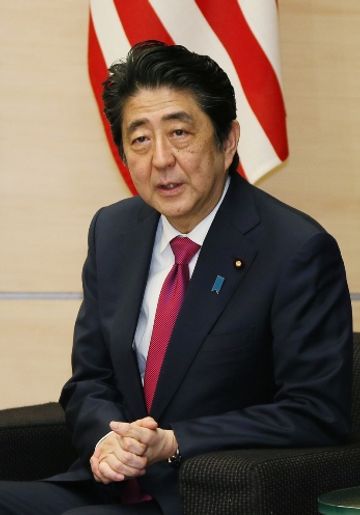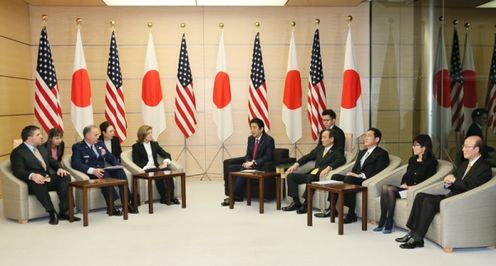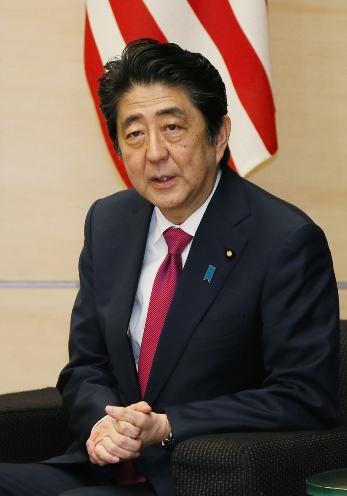Home > News > The Prime Minister in Action > December 2016 > Joint Japan-U.S. Announcement on the Return of a Major Portion of the Northern Training Area
The Prime Minister in Action
Joint Japan-U.S. Announcement on the Return of a Major Portion of the Northern Training Area
December 21, 2016

Photograph of the Prime Minister making a statement (1)

Photograph of the Prime Minister making a statement (2)
[Provisional Translation]
On December 21, 2016, at the Prime Minister’s Office, Prime Minister Shinzo Abe made a Japan-U.S. Joint Announcement on the Return of a Major Portion of the Northern Training Area (NTA) with H.E. Ms. Caroline Kennedy, Ambassador of the United States to Japan.
The Prime Minister stated in his opening statement,
“Ambassador Kennedy, distinguished guests, thank you all for coming today.
The land return of 4,000 hectares at the NTA has been our agenda, pending for two decades. In my policy speech at the Diet in September, I said, “This cannot be delayed any longer.” The entire government has been engaged to achieve the early realization of this matter.
Earlier it was reported to me that Japan and the United States have come to an agreement, and the land return will be realized tomorrow. The 4,000 hectare return accounts for about 20 percent of the U.S. facilities and areas in Okinawa, and is the biggest single return since the reversion of Okinawa.
I would like to express my gratitude to all those on the U.S. and Japan sides who worked for producing this result on this challenging issue. I am very pleased that we can announce our great achievement today with Ambassador Kennedy and all of you.
This land return does not only mitigate the impact of the bases, but also makes a major contribution to local development through effective use of the returned land. The Government will provide the maximum support to the local villages of Higashi and Kunigami in efforts to register the land as a national park, and then as a world natural heritage site.
At the same time, we will of course provide due consideration to the people affected by the relocation of the helicopter landing zones, and the Government will continue to cooperate with the U.S. side to pay careful attention to the local living environment.
Ensuring the safe flights of U.S. military aircraft is a grand premise for the smooth stationing of the U.S. forces in Japan. We will work closely with the U.S. side and exert utmost effort to make full assurance on this.
I would like to continue to further strengthen Japan-U.S. ties, and, based on a strong relationship of trust, to steadily implement measures one by one to produce results, in order to realize impact mitigation in Okinawa, while also maintaining deterrence.”
After a statement by Ambassador Kennedy, the Prime Minister said,
“I would like to once again express my respect for all the work dedicated on both the Japan and the U.S. sides for the return of the 4,000 hectares of the NTA.
In regard to impact mitigation in Okinawa, the Abe Cabinet is exerting its full efforts, under a principle that ‘we do everything we can.’ Two years ago, we realized the transfer of all the 15 tanker aircraft from Futenma to Iwakuni. This had been an issue for over 18 years.
We also realized the return of the West Futenma Housing Area last year, and the construction of a hospital on the site has already been decided. Moreover, the relocation of 9,000 U.S. Marines to Guam, which was previously halted in the U.S. Congress, is now moving towards its realization after the continuous efforts made by the Government of Japan and U.S. Congress.
Furthermore, we must avoid the indefinite use of MCAS Futenma, which is located in the center of an urban area surrounded by residential buildings and schools. I believe both the Japan and U.S. share a common understanding.
Through close Japan-U.S. collaboration, we will continue to steadily advance the realignment of the U.S. forces in Japan, and, at the same time, we will realize impact mitigation in Okinawa, in a visible form, while maintaining deterrence. I would like to ask for your continued cooperation to this end.
I believe that the Japan-U.S. Alliance is stronger than ever in the history of both countries. Through this strong bond, I would like to continue to work together with the United States for the greater peace and stability of the region. Thank you.”


